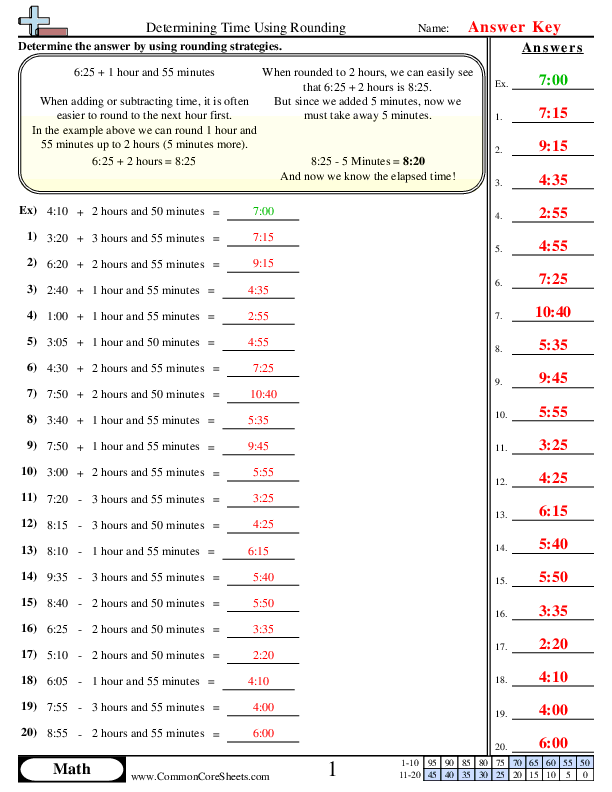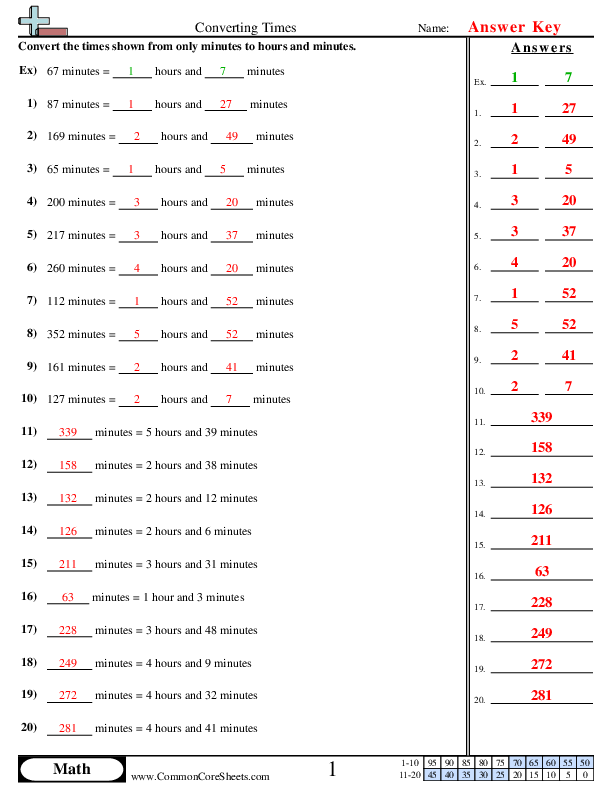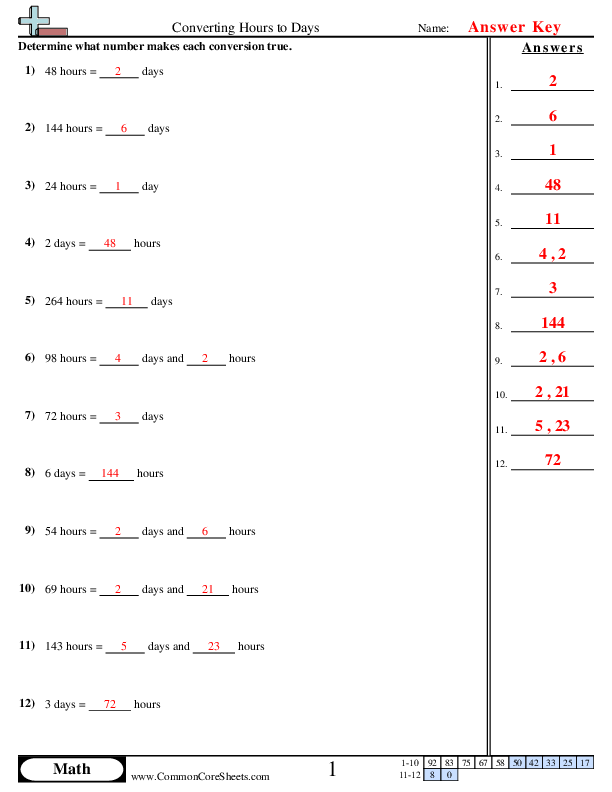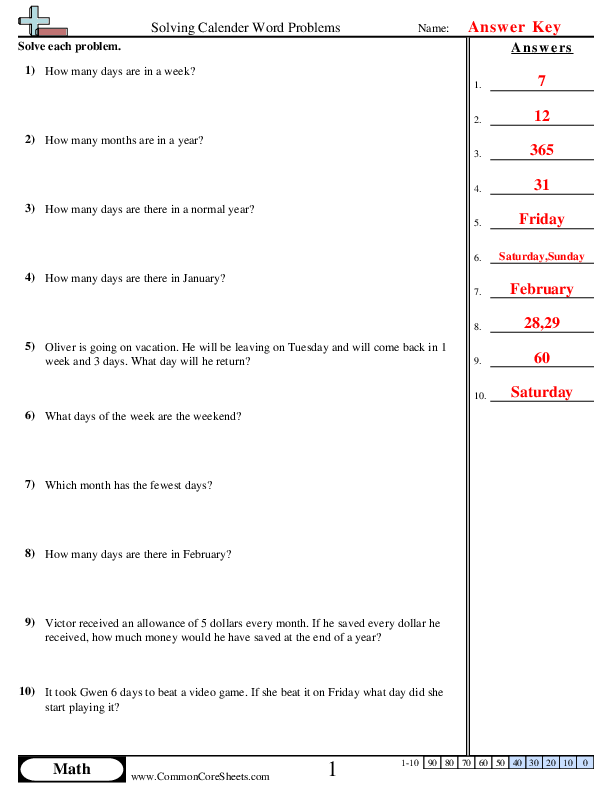Are you looking for the best time worksheets on the internet? Look no further! Our free time worksheets are perfect for teaching students to read a clock, calculate elapsed time, solve start and ending times, and tackle word problems. Our interactive worksheets make it easy for students to learn important concepts related to telling time and understanding intervals between two points in time. With our engaging activities, your students can quickly and accurately practice all of the skills related to telling time. No more wasting "time" looking for worksheets, get your students learning with our top-notch time worksheets today!
Browse Sheets By Problem Type
×

Determining Time (Using Rounding)
3md1


×
Description:
"This worksheet is designed to improve children's math skills, specifically in determining time using rounding. The sheet includes 20 problems featuring various time additions which challenge learners to improve their understanding of time structure. This customizable material can be converted into flash cards, making it a versatile tool for in-person or distance learning environments that can be tailored to individual student needs."

×
Student Goals:
Understanding Time ConceptsAfter completing the worksheet, students should have a solid understanding of time concepts. They will be adept at reading time and have a better grasp of how hours and minutes are accumulated to form a whole day. Understanding the value of time and how it operates is a critical skill that will not only aid their mathematics studies but also their daily life. They will be able to schedule their daily activities more effectively by understanding how time adds up.Rounding SkillsThe worksheet will significantly improve students’ rounding skills. Rounding is a crucial concept in mathematics and other subjects that involve computations. It helps simplify numbers to make them easier to comprehend and operate on. Students will, therefore, gain an understanding of the importance of rounding in approximating numbers, specifically in the context of time management. They will be more capable of estimating and interpreting time durations following the completion of the worksheet.Ability to Calculate Time DifferencesUpon completing this worksheet, students should have developed the ability to calculate differences in time. This is a valuable and practical skill that can be translated into real-life situations like computing travel time, duration of events, or calculating project timelines. It will aid students not only in their math curriculum but also in daily situations that require scheduling, planning, and understanding the relationship between durations of time.Improvement in Mental MathStudents will also boost their mental math skills after going through the given problems. The worksheet offers a fun and practical way for students to exercise their mind and enhance their calculation speed and accuracy. Since most questions require mental computation, students will get to flex their brain muscles and this, in turn, solidifies their numerical fluency.Problem Solving and Logical Thinking SkillsThe worksheet enhances students' problem-solving and logical thinking skills. By determining time using rounding, learners will be challenged to use their critical thinking abilities and analytical skills. This cognitive development will not only benefit their math capabilities but will also be useful in other areas, as problem-solving and logical thinking are universally applicable skills.



Converting Times
3md1


×
Description:
"This worksheet is designed to facilitate math learning by relating minutes to hours. The title, 'Converting Times', covers 20 problems aiming at improving students' numerical conversion skills. Problems range from converting 75 to 346 minutes into hours and minutes, ideal for establishing a solid understanding of time. The customizable nature allows for adaptability to various teaching methods like flash cards or distance learning platforms."

×
Student Goals:
Develop Mathematical ProficiencyAfter completing the worksheet, students should have developed proficiency in mathematical concepts, particularly in time conversion. This includes translating figures from minutes to hours and vice versa, a basic but crucial aspect of time comprehension.Master Time Management SkillsThe ability to convert time is not only a pure academic exercise but also a skill that is useful for time management. By mastering conversion between hours and minutes, students can apply this knowledge in scheduling their tasks and activities, enhancing their ability to manage time more efficiently.Enhance Problem-Solving SkillsSolving mathematical problems involves critical thinking and problem-solving skills. Each problem in the worksheet requires students to decipher and understand the question, use appropriate strategies to solve the problem, and verify their answers. Therefore, completion implies improved problem-solving capabilities.Foundation for Advanced Time ConceptsAs students master the simple concept of time conversions, they are laying a solid foundation for more advanced mathematical concepts related to time. This includes calculating elapsed time or determining differences in time zones, all of which are necessary for further mathematical studies and real-life applications.Improvement in Reading and Interpreting Numerical DataBy working on the worksheet questions, students are also practicing their ability to read and interpret numerical data. Through the repetition of similar problems with varying numbers, students are enhancing their quick response capability and improving their ability to interpret different visual forms of data.Confidence in Mathematical AbilitiesFinally, by successfully completing the worksheet, students gain confidence in their ability to solve mathematical problems. This is an important step in creating a positive attitude towards learning and achieving in mathematics or other numeracy-rich subjects.



Identifying Time Phrases


×
Description:
"This worksheet is designed to help children identify and comprehend time phrases. Covering 20 problems on a math-based subject, it focuses on interpreting phrases related to clock readings such as 'Five after 4' or 'Quarter to 11'. Customizable for different learning approaches, it can be transformed into flash cards or used effectively in distance learning scenarios to enhance children's understanding of time concepts. It serves as an engaging tool to reinforce time telling skills."

×
Student Goals:
Understanding Time ConversionsBy successfully completing this worksheet, students should develop a solid understanding of time phrases and how to convert them into digital format. They should master recognizing and interpreting phrases such as 'quarter to', 'quarter past', 'five after', and 'five to' pertaining to the standard clock. This skill is essential in everyday life, and also sets a foundation for further studies in time management and scheduling.Mathematical Reasoning EnhancementThe process of converting time phrases into the corresponding numerical values will improve the student's mathematical reasoning skills. The task requires logical thinking and an understanding of how the standard clock works. This experience will help build their numerical and logical problem-solving abilities, which are important aspects of both their academic and personal life.Increase in Precision and Attention to DetailWorking on this worksheet will foster increased precision and attention to detail in students. Managing time measurements, even at a minute level like 'five after' or 'five to', requires a great deal of accuracy. Therefore, this task will promote meticulousness among students and help them learn the importance of precision in the field of math and beyond.Conceptual Understanding of TimeThe worksheet will help students to establish a conceptual understanding of time. Through the process of converting time phrases into their digital format, students will reinforce their understanding of the system of hours and minutes and how they relate. This understanding is crucial for other concepts like scheduling and time management.Development of Independent Problem-Solving SkillsStudents will develop the ability to independently solve problems. The worksheet trains the students to manage problems by themselves, thus, nurturing their ability to make decisions, apply strategies, and verify solutions. These skills are important for enhancing a student's self-reliance and confidence.



Converting Hours to Days


×
Description:
"This worksheet is designed to enhance children's understanding of time conversion, specifically from hours to days. It offers 12 math problems that exhibit different conversion scenarios, promoting hands-on learning and the application of mathematical concepts. Suitable for distance learning, this adaptable resource can be customized to varying difficulty levels or converted into flash cards for engaging, interactive education."

×
Student Goals:
Understanding Time ConversionUpon completing the worksheet, students will have a firm grasp on the concept of converting time between hours and days. This knowledge goes beyond merely academic knowledge, as this understanding has practical uses in everyday life. It aids in better time management and planning of activities, contributes to their development of logical reasoning and enhances their problem-solving skills.Enhanced Mathematical Tasks Solving SkillsBy completing the twelve problems in the worksheet, students will be able to enhance their mathematical skills. It gives them an opportunity to practice a variety of problems which helps them to understand how to apply appropriate methods at the right time to solve problems correctly. As they gradually solve problems, they will be able to gain confidence in their ability to handle similar mathematical tasks.Practical Application of Multiplication and DivisionIn solving the problems on this worksheet, students will have effectively applied multiplication and division skills to convert hours to days and vice versa. This reinforcing process is valuable for ensuring that students are able to correctly use these two fundamental mathematical operations in a practical, real-world sense.Decision Making SkillsSolving problems in the worksheet will enhance the decision-making skills of the students. They learn to analyze problems and make decision whether to multiply or divide to achieve a correct result. This practice eventually helps them to make efficient decisions in complex problem-solving scenarios.Accuracy and Precision DevelopmentWhile working on the worksheet, students learn the importance of precision and accuracy. The mathematical computations involved in the conversion of days to hours and vice versa require paying attention to small details, promoting the development of these important skills which are transferable to many other subject areas and life scenarios.Cognitive DevelopmentSolving the problems will challenge the students mentally, thereby improving their cognitive abilities. It broadens their thought processes and improves their analytical thinking ability. This will not only aid them in mastering the conversion of hours to days but also develop their overall cognitive abilities which are essential for other complex problem solving tasks.



Converting Days to Weeks


×
Description:
"This worksheet is designed to bolster math proficiency by teaching kids how to convert days to weeks, and vice versa. With twelve interactive exercises, children engage with core concepts of time in a fun, hands-on way. It's highly adaptable, ideal for use in distance learning, and can be customized into flash cards for additional practice. By mastering these routines, children acquire a key skill that helps them understand and appreciate time's role in our lives."

×
Student Goals:
Gain Full UnderstandingAfter completing this worksheet, students should have developed a complete understanding of converting units of time between days and weeks. This is a fundamental skill in mathematics and is necessary for many practical situations, such as scheduling and time management.Apply Mathematical ConceptsStudents should be able to correctly apply the mathematical concepts in practical scenarios. The worksheet exposes learners to different problems, allowing them to explore different ways of applying the same concept. This practical exposure is beneficial for students, enabling them to understand how mathematical concepts are used in everyday life.Boost Problem-Solving SkillsWith the diverse set of problems in the worksheet, students will have their problem-solving skills challenged and sharpened. This worksheet is not only a measure of their current understanding but also a means to improve their strategic thinking ability. By solving these problems, they can improve their critical thinking and logical reasoning skills.Improve Speed and EfficiencyBy practicing the conversion between days and weeks repeatedly, students should see a significant improvement in their calculation speed and efficiency. Regular practice promotes speed, accuracy and it also aids in the mental memory of key conversion factors.Preparation for Advanced ConceptsThis worksheet may serve as a foundation for learning about more complex units of time further in their education, such as leap years, fortnights, etc. It would be a starting step for more complex calculations involving weekends, hours, and even seconds.Verification of CalculationLearners should be able to confidently check the correctness of their calculations. The problems offered in this worksheet require a solid understanding of both multiplication and division. This supportive learning tool allows students to examine their working methods and learn how to self-correct their mistakes.Increase in ConfidenceAs a final accomplishment, successfully working through these exercises should result in an increased confidence in handling mathematical problems. With regular practice of similar tasks, children can develop the habit of not hesitating or fearing errors, but viewing them as an opportunity to learn.



Reading a Calender


×
Description:
"This worksheet is designed to improve children's mathematical and chronological thinking. The 10-problem sheet titled 'Reading a Calendar' teaches concepts related to calendar reading, like identifying weekdays, counting days, and understanding sequence of events. Malleable and adaptable, this worksheet can be customized, transformed into flashcards for a handy learning tool or utilized optimally in distance learning environments."

×
Student Goals:
Understanding Dates and WeekdaysUpon successful completion of this worksheet, students will be able to accurately determine the day of the week for specific dates, enhancing their understanding of the calendar system. This will allow them to effectively plan and prepare for upcoming events, tasks, or activities.Developing Problem-Solving SkillsBy solving different math problems related to calendars, students will be able to enhance their problem-solving skills. These challenges require them to dissect numerical data related to days, dates, weeks, and months, critique it thoughtfully, and employ mathematical operations to come up with correct answers.Efficient Time ManagementStudents will learn how to calculate the number of days between two dates or from a specified time in the future. This will aid in developing time management skills and make them conscious of the passing of time and the importance of making every day count.Understanding Time-Based ConceptsThis worksheet will also enhance students' understanding of time-based concepts such as weeks, days, months, and how they relate to each. This understanding is crucial in daily life, ranging from knowing when holidays or birthdays are to determining when assignments are due.Improving Mathematical SkillsAs this worksheet incorporates math-based problems related to the calendar, it will also help in improving students' mathematical skills. The application of numbers, counting, and simple mathematical principles in a practical context makes it a valuable tool for sharpening numeracy skills.Building ConfidenceBy successfully determining answers for each problem, students' confidence will be boosted. This confidence can further produce stronger academic performance as students feel competent and motivated to tackle more advanced tasks.



Solving Calender Word Problems


×
Description:
"This worksheet is designed to enhance children's math skills through 10 engaging calendar word problems. Concepts covered include calculating timelines, understanding weekly and monthly cycles, and identifying specific days. Perfect for customization and conversion to flashcards, it's also well-suited for distance learning settings, offering an interactive way to bolster numerical acumen and calendar comprehension."

×
Student Goals:
Basic Calendar ComprehensionAfter completing this worksheet, students should have a solid understanding of the structure and function of a calendar. They should be able to identify the days of the week, the number of days in each month, and the total number of days in a year. This comprehension serves as a foundational skill in their academic journey, aiding future tasks related to planning, organization, and time management.Time Calculation ProficiencyStudents will accomplish the ability to calculate the passage of time in different scenarios. They must grasp the concept of durations such as weeks, months, and years, and effectively apply these to real-world contexts. Whether it is determining the amount of money saved over a period, estimating the return date from a vacation, or calculating game completion times, students will develop a practical skill set for time calculation.Application of Mathematical ConceptsThis worksheet will aid students in applying their knowledge of addition and multiplication indirectly through word problems. The skill to visualize and execute mathematical operations using text-based problems is crucial for their problem-solving capabilities in the future. Relating dollar amounts to periods or deducing start and end days integrates math problems into daily life scenarios.Problem-Solving SkillsUpon completing this worksheet, students should have honed their ability to solve word problems. By translating real-life examples into numerical data and using their knowledge of calendars, they can find solutions to practical problems. This fosters their logical thinking, reading comprehension, and analytical thought process, which are integral for their overall scholastic and future career success.Calendar ReadingStudents should be confident in reading a calendar accurately upon completion of the worksheet. They should be able to navigate around months, weeks, and days and further identify special cases such as leap years or the unique case of February. By mastering these elements, students will have developed the proficiency to plan and manage their time better both in academia and in their daily lives.








